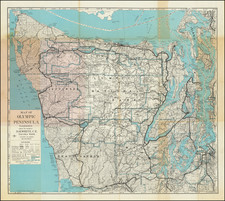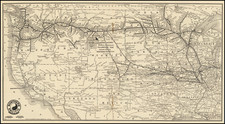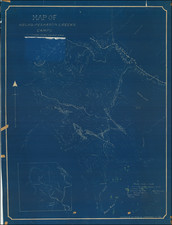First Map of Whatcom, Washington Territory -- A Future Part of Bellingham
Rare pair of blue print maps on a single sheet, printed back to back, illustrating the town of Whatcom, which is now part of Bellingham.
The present map is a contemporary blue print example of the first map of the town of Whatcom. At the top left of the first map, the Dedication identifies the owners of the real estate which became the town, including a transfer of the lands necessary to create strees, alley and a park.
On the verso, a supplmental map shows the same map with virtually identical information, but adds a number of new signers as of December 1886.
Blueprint & Blue Line maps (Cyanotype Printing)
Blueprint and blue line maps were among the most popular means for the swift printing of maps for which there would be a limited demand. A blueprint or blue line map could be made and/or revised much more quickly than a lithograph, cerograph, or other printing method, and at a much lower cost.
This method of printing was invented in 1842 by John Herschel, a chemist, astronomer, and photographer. A cyanotype process, one starts by drawing on semi-transparent paper, weighted down by a top sheet of paper. The paper would be coated with a photosensitive chemical mixture of potassium ferricyanogen and ferric ammonium citrate. The paper would then be exposed to light, wherein the exposed portions turned blue and the drawn lines, protected from exposure, would remain white.
The cyanotype printing process was an improvement on the expensive and time-consuming method of hand-tracing original documents. The technique was particularly popular with architects; by the 1890s, a blueprint was one-tenth the cost of a hand-traced reproduction. It could also be copied more quickly.
Blueprint and blue line maps began to appear as early as the 1850s and 1860s, but they really began to become the standard for mining and similar limited-purpose maps by the 1880s. The ability to create these maps quickly and at a low cost made them the standard for short-run prints, ideal for mapping mining regions in the West and for similar purposes.
The method still exists today, but in a very limited fashion. In the 1940s, diazo prints (whiteprints or bluelines) became more popular, as they were easier to read and faster to make. The blue lines on a white background of these prints are now what most people call blueprints.














![[ California To Alaska -- Northwest Passage ] Quivirae Regnu cum alijs versus Borea](https://storage.googleapis.com/raremaps/img/small/60083.jpg)

![[ North Fork Snoqualmie River -- Calligan Lake ] Township No. 25 North, Range No. 9 East.](https://storage.googleapis.com/raremaps/img/small/101663.jpg)